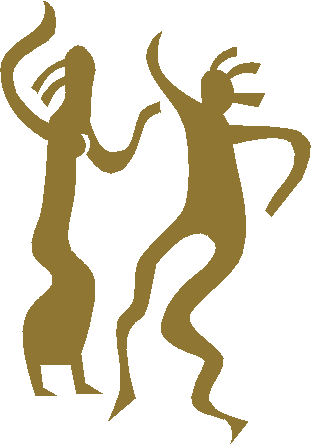You are here: Victoria's
Dance Secrets > ABCs of
Dance > Dance Rhythm
DANCE
RHYTHM
 [Complete Rhythm Chart] [Single Rhythm] [Double Rhythm]
[Triple Rhythm] [Waltz Rhythm] [Complete Rhythm Chart] [Single Rhythm] [Double Rhythm]
[Triple Rhythm] [Waltz Rhythm]
Dance rhythm is established by
the number of weight changes within two beats of music or one UNIT of
dance.
In any given dance rhythm unit, it is possible to
have no weight change, a single weight change, or as many as 6 weight changes (that is if
your feet are fast enough), in two beats of music.
Because of the importance of rhythms in dance, it is necessary
to have an annotation system which will clearly and distinctly differentiate these rhythms
from one another. These annotations are the ‘flash cards’ to graphically show
the weight changes that take place in two beats of music.
 |
A RECTANGLE is used
to separate and identify each set of 2 beats of music in every two-beat unit of
dance. |
 |
SOLID DOTS inside the rectangle indicate actual weight changes. |
 |
SLASHES within the rectangle indicate the beats of music where no weight
changes occur. |
Every
pattern in every dance is composed of arrangements and re-arrangements of four primary
rhythm units.
BLANK UNIT
- No Steps or Weight Changes
| 1
2 |
1
2 |
 |
 |
SINGLE
RHYTHM - One Step (on the down-beat)
| 1
2 |
1
2 |
 |
 |
DOUBLE
RHYTHM - Two Steps (one on each beat)
| 1 2 |
& 1
2 |
 |
 |
TRIPLE
RHYTHM - Three Steps (one on each beat plus the
“&” or "a" count)
| 1
& 2 |
1
a 2 |
 |
 |
(Musicians and music
scholars may confuse the dance triple rhythm unit with the musical duple meter
because of the two main beats in the unit. Just remember that dance rhythms are composed
of weight changes and other movements necessary to each dance.)
Weight changes or
steps are identified by large dots and no changes are either left blank or indicated by
slashes. A Blank space means nothing is done on that count. A slash, on the other hand
means that we don’t step, but do something else on that beat of music.
Thus, we if STEP on the first beat of the unit,
and do something else (tap, kick, touch...) with the free foot on the second beat , then
it will be a single rhythm unit. If we step on both beats of the unit, it will be a double
rhythm unit.
If we step three times within two beats, then it
is a triple rhythm unit. A triple rhythm is not 3 equal weight changes; it is merely two
steps on the same foot, with a less weighted step in between.
If we do something (except changing weight) with
the free foot on the first beat of music and ‘hold’ it on the second, it will be
a blank rhythm unit.
All dance patterns,
whether basic or variants or syncopations, are mere arrangements and rearrangements of
these four primary dance rhythm units. A dance pattern may be composed of as little as one
unit. Sequences may have as many as 12 or 15 rhythm units. Some patterns consist of only
one type of unit, others are combinations of the different types. Some examples:
DANCE WALK
TANGO CLOSE
| 1
2 |
1
2 |
3
4 |
 |
 |
 |
| Walk
Walk |
Forward
Side |
(Touch)(Hold) |
| DOUBLE |
DOUBLE |
BLANK |
BOOGIE
(Two-Beat Jive)
| 1
2 |
3
4 |
5
6 |
 |
 |
 |
| Back Forward |
(tap)
Step |
(tap) Step |
| DOUBLE |
SINGLE |
SINGLE |
WEST
COAST SWING
| 1
2 |
3
& 4 |
5
& 6 |
 |
 |
 |
| Back Forward |
Step 3 Times |
Step 3 Times
|
| DOUBLE |
TRIPLE |
TRIPLE |
The possible combinations of these rhythm units into rhythm patterns are limited only by
the endless variety of existing dance forms, sequences, and syncopations, and
those that are still being developed. Try substituting an odd rhythm (single or triple)
with another odd rhythm, or an even rhythm (blank or double) with another even rhythm.
[Complete Rhythm Chart] [Single Rhythm] [Double Rhythm]
[Triple Rhythm] [Waltz Rhythm]

|
